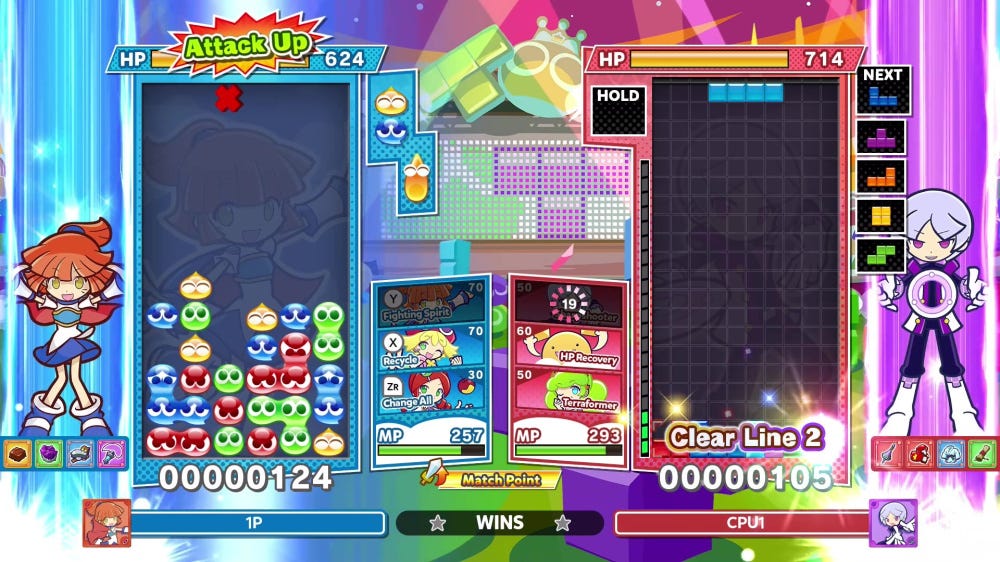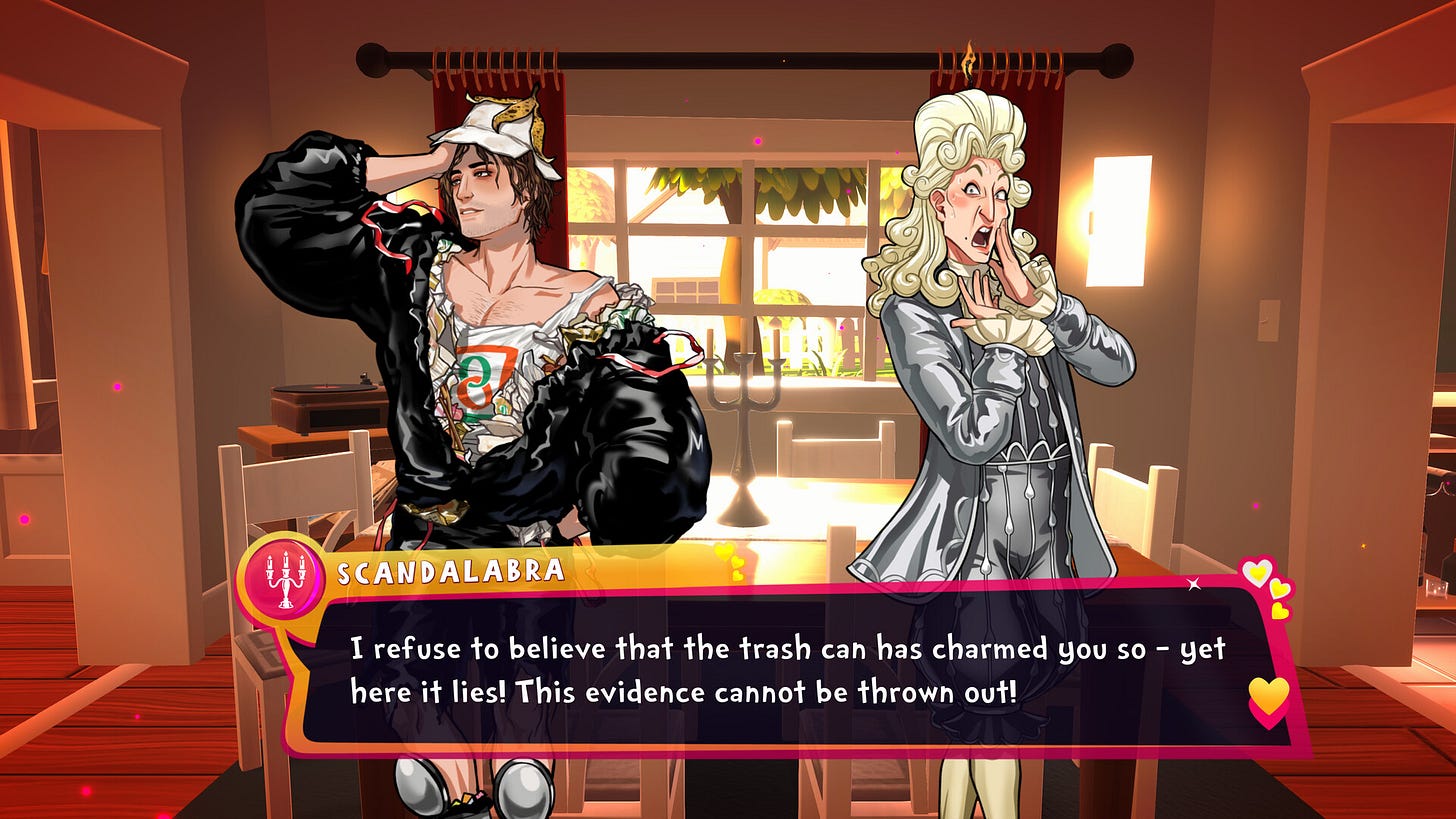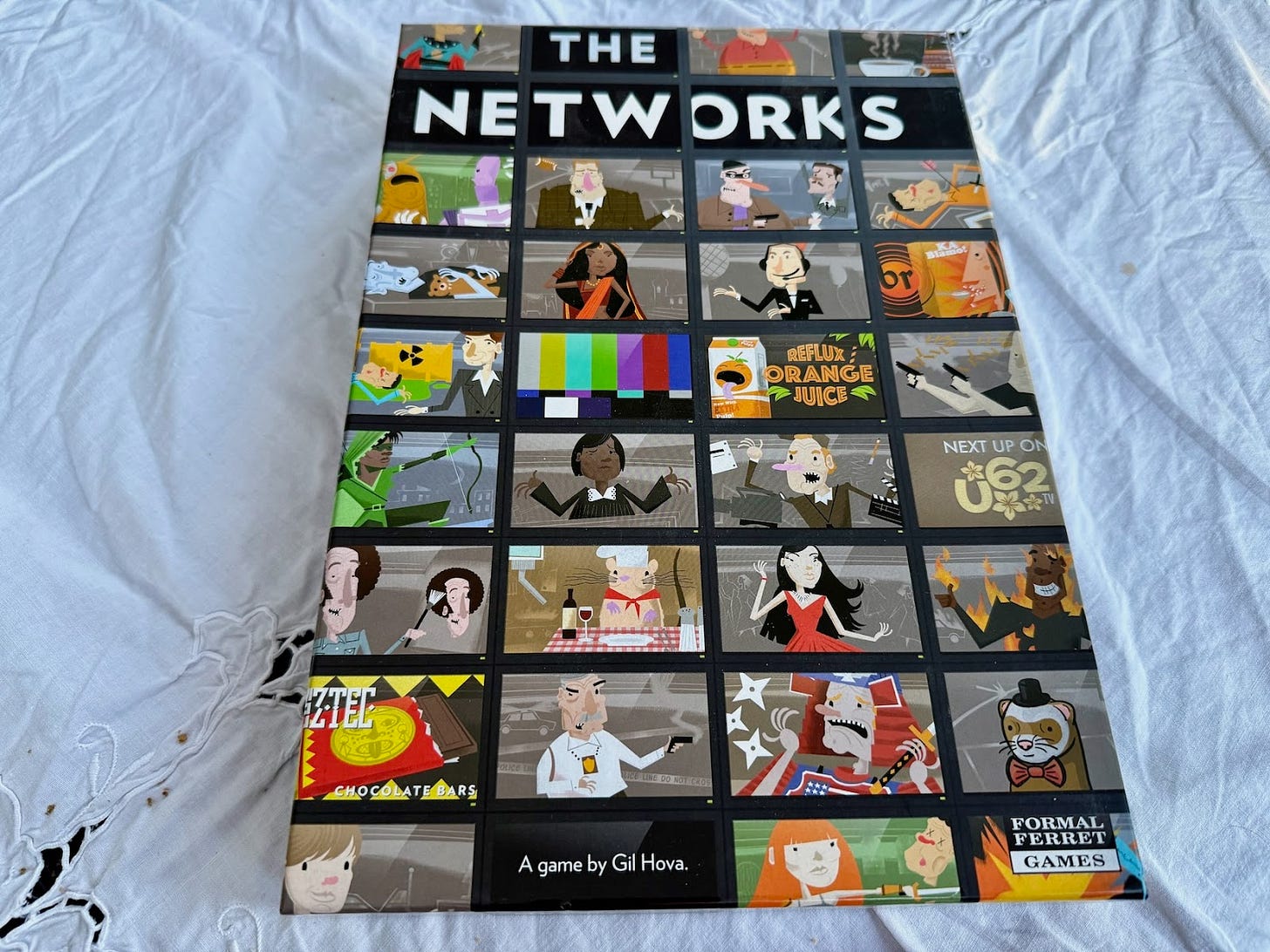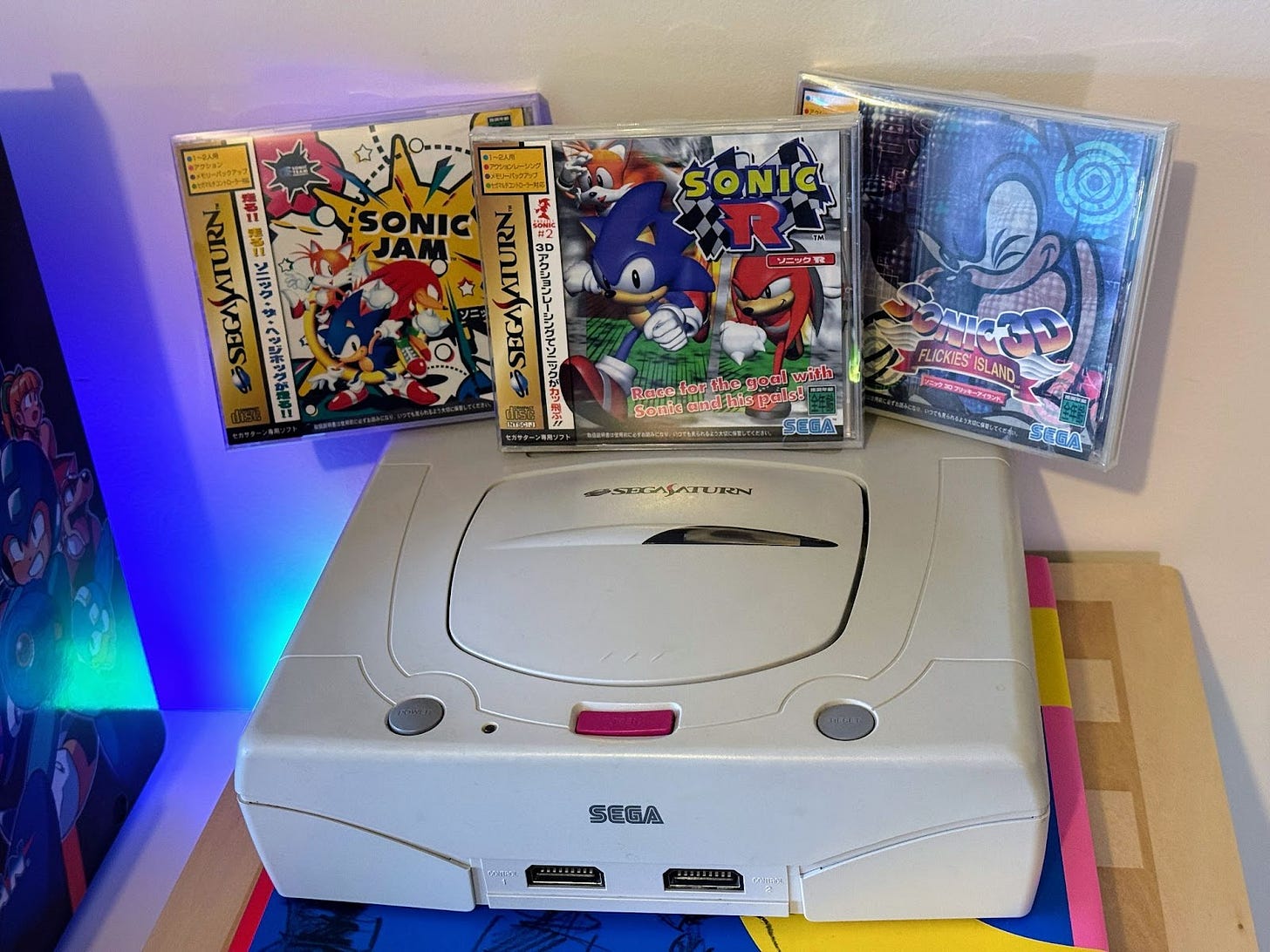The Switch 2 Already Has Unnecessary Remasters. Nature Is Healing.
Plus the battle of the handhelds, The Networks board game, and Sonic The Hedgehog's lost era
Happy Tuesday, friends,
We’ve now had the Switch 2 for a couple of weeks, and already there is an unnecessary full-priced re-release of a game. On the one hand, this sucks. On the other hand, it’s a real Nintendo console now.
This week I (Alice) dive into Puyo Puyo Tetris 2S and network TV scheduling The Networks, while Tim ponders the state of handhelds and the forgotten Sonic The Hedgehog era. Plus, our recommendations of what to play this week.
Enjoy!
Did this need a full price re-release? No (but it’s still fun)
By Alice
Puyo Puyo Tetris 2 is one of those puzzle games that I keep coming back to. It came out relatively early in the original Nintendo Switch’s lifecycle, and I loved discovering Puyo Puyo (essentially a match 4 puzzle game) through it, though I did mostly stick to Tetris when I could.
So, when Puyo Puyo Tetris 2S came out for the Switch 2, I was keen to see how it had evolved. Surely, given the game is selling for $60, there would be myriad improvements for us all to enjoy.
Sadly, not really. It’s the same great game, just at a new, higher price, and if I wasn’t so annoyed I would respect the hustle.
It has the same delightfully non-sensical “story”, same gameplay, (to my eye) the same graphics. It’s the same game. It just also has support for the camera (so your face can replace the character avatar), better lobby filters that should have been in the original game, mouse controls (that don’t really make sense to use because you can be more precise with stick controls), and some slight bug fixes. At most it should have been a $5 upgrade pack. But, now, because there isn’t cross play, so you can’t compete against Switch 1 players if you have the Switch 2 version of the game, the whole online player base is going to be splintered.
If you don’t already have the original Switch version of Puyo Puyo Tetris 2, and love puzzle games, then this is a must have. But if you do already have an original Switch version of the game, and are wondering if it’s worth upgrading for the Switch 2: it’s not.
What to play
New to Game Pass this week is the brand new Rematch, a competitive online soccer game from the makers of cult favourite fighters Absolver and Sifu. Also arriving imminently is Volcano Princess, which at a glance looks like a girl-raising life sim in the vein of Princess Maker.
Fans of dating sims and visual novels should take a look this week at Date Everything, a game I (Tim) have been anticipating for a long time. You gain the fascinating and highly suspicious capability to turn all the objects in your house into hot and flirty singles, with each one being brilliantly designed and voiced.
Free on the Epic Games Store this week is puzzle game The Operator. The trailer claims it’s a narrative crime-solving adventure, and that sounds pretty good. Worth a shot for free.
The battle of the handhelds
By Tim
If you just want one handheld device for gaming, and you want it to play brand new titles, the competition for your money looks like it will really heat up over the coming year. So, what are your options?
The Switch 2, for its part, has eliminated the main issue holding the old Switch back, introducing enough grunt to support a broader range of new third party games. It’s also the only place you’ll find Nintendo’s stuff, and should remain an excellent platform for Indies. But it does have its drawbacks.
Old Switch games aren’t automatically reconfigured to suit the Switch 2, making for little to no increase in performance, and some muddy visuals. And while I was impressed by the display at first glance (playing Mario Kart at the first media preview event), its shortcomings are clearer now I have it at home. It’s not very bright, and motion clarity is sub-par, which you’ll notice immediately when you play any game you’re used to seeing on the Switch OLED.
Still, it’s 1080p and has support for up to 120Hz VRR, which is important. And games with HDR look great when attached to the dock, which leads to another point in Nintendo’s favor; the controller, TV docking and performance situations are all turn-key, with no tinkering needed.
Then you have PC handhelds. The Steam Deck OLED is still king here, as far as I’m concerned. What the display lacks in resolution and refresh (800p, 90Hz) it makes up for in brightness, contrast and clarity. Power and controls are very configurable, and while it works best with Steam games you can realistically load anything you want onto it. Downsides? It’s much bulkier than the Switch 2, and it’s a PC at heart meaning some fiddling is required for anything beyond the absolute basics. It’s also in need of a chip refresh, as it can’t run the most demanding games.
Currently I find Windows handhelds tough to recommend. The best ones are technologically superior, but the user interface sucks to an excruciating degree. Valve is now allowing other manufacturers to use its SteamOS software, which could create an ideal machine. Meanwhile Microsoft is talking about Windows engineers working on this problem for the upcoming ROG Xbox Ally though, which is also promising.
And then there’s Sony. A portable high-end PlayStation would be a compelling device, but currently what we have is the Portal. A great screen, and excellent controller, but it only works in conjunction with the PS5 as a streaming device. The rumored version that can run games locally is likely still a long ways off.
Bricks, Boards and Beginnings
by Alice
Over the weekend I played The Networks a board game that harkens back to the days when people watched network television. You play as a network executive who has to draft shows, time slots, stars and ads, as well as Network Cards which can give special powers.
The aim of the game is to get the most viewers by the end of the five seasons, and there are a few different ways to earn them: stars boost viewers, TV shows have higher viewers in their first few seasons (so you have to be strategic about when to move them to reruns), some ads give viewers if in their preferred time slot, there’s a way to buy viewers if certain conditions are met, and Network cards can give some viewers. There are a lot of different strategies you can employ, and different paths to victory. While there is an aspect of luck involved, it’s more heavily weighted towards player choice, so successes and failures feel earned.
The game itself is really fun. I enjoyed having to think through my options, and once I’d gotten the hang of the game, being able to look towards the final round to strike and earn my viewers was thrilling, because it meant my game hinged on whether a single card was available to be drafted in the final round, and if I could get it first.
However, as fun as the gameplay is, the real highlight is seeing all the silly names for the TV shows, making fun of real shows from the 2010s, as well as the funny ads and star descriptions. It’s the kind of game that even casual enjoyers of that period of television will be able to appreciate and laugh at.
The Networks is light, perfect for a Sunday afternoon over tea and biscuits, or for after a dinner party when continuing to gossip. I strongly recommend it.
Retro Esoterica
by Tim
If you like Sonic the Hedgehog, you probably prefer one of two retro eras; the 16-bit games of the early 90s, or the 3D games that kicked off as we began a new millennium. But what happened to Sonic in the time between?
It’s not that the hedgehog was completely missing between Sonic & Knuckles and Sonic Adventure, and in fact there were three games released for Saturn. But the short life of that system, and its general lack of popularity outside of Japan, means you can consider this Sonic’s lost era.
Sonic 3D: Though primarily developed for the Mega Drive in 1996, a far superior Saturn version was released that same year, at least in the US. With higher resolution versions of the pre-rendered sprites, extra detail and effects, redone music, a 3D bonus stage and analogue stick support, it’s an excellent version of an okay game. For whatever reason it didn’t reach Japan until 1999, in a version that was ever so slightly tweaked and optimised a bit further.
Sonic Jam: The Saturn was in trouble by 1997, with Sony eating its lunch and Sonic Xtreme cancelled before its proposed holiday ‘96 launch. Jam is primarily enhanced ports of the three Mega Drive games, with some design changes and difficulty options. But it also includes an explorable 3D hub that gives a taste of what Xtreme might have been, alongside heaps of historical Sonic stills, music and videos (including a trailer for the Japanese OVA).
Sonic R: The only completely original Sonic on the Saturn, this is a 3D racing game where most characters are on foot. The control can take some getting used to, but it’s a charming game with a great vocal soundtrack, some fun collectibles and unlockable characters (Metal Knuckles! That creepy Tails Doll!), and pleasingly primitive polygonal graphics. The main drawback is its short length; there are only four race tracks to explore, plus one to unlock.









